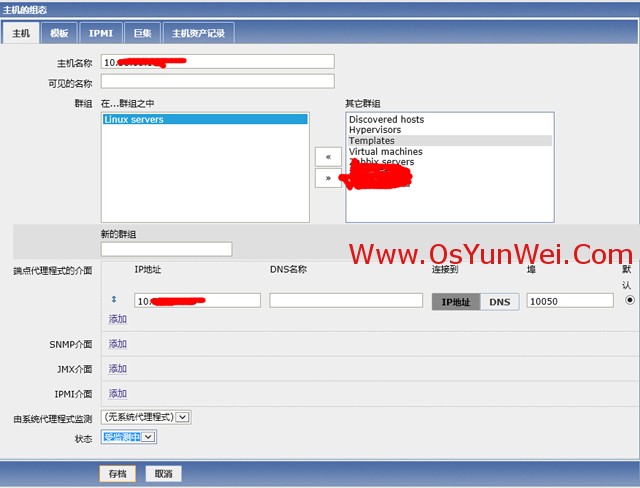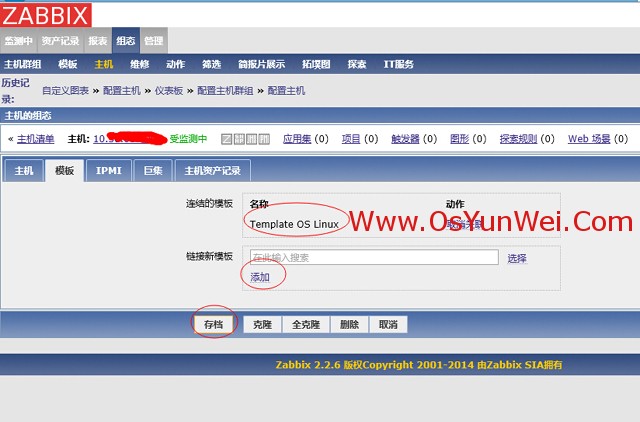How to set up Zabbix monitoring Linux host
Instructions:
The Zabbix monitoring server has been configured. Now you need to use Zabbix to monitor the Linux host.
Specific operations:
The following operations are performed on the monitored Linux host. Here we take the CentOS 6.x system as an example.
1. Configure the firewall and open TCP and UDP ports 10050 and 10051
vi /etc/sysconfig/iptables #Edit the firewall configuration file
-A INPUT -s 192.168 .21.127 -m state --state NEW -m tcp -p tcp --dport 10050:10051 -j ACCEPT
-A INPUT -s 192.168.21.127 -m state --state NEW -m udp -p udp --dport 10050:10051 -j ACCEPT
:wq! #Save and exit
service iptables restart #Restart the firewall to make the configuration effective
Explanation: 192.168.21.127 is Zabbix The IP address of the server means that the port is only open to this IP. If it is to be open to all IPs, the rules are as follows:
-A INPUT -m state --state NEW -m tcp -p tcp --dport 10050: 10051 -j ACCEPT
-A INPUT -m state --state NEW -m udp -p udp --dport 10050:10051 -j ACCEPT
2. Close SELINUX
vi /etc/selinux/config
#SELINUX=enforcing #Comment out
#SELINUXTYPE=targeted #Comment out
SELINUX=disabled #Add
:wq! #Save and exit
setenforce 0 #Make the configuration take effect immediately
3. Install Zabbix client
1. Download zabbix software package
zabbix-2.2.6
http://jaist.dl.sourceforge.net/project/zabbix/ZABBIX%20Latest%20Stable/2.2.6/zabbix-2.2.6.tar.gz
Upload zabbix-2.2.6.tar.gz to the server/usr/local/src directory
2. Add user
groupadd zabbix #Create user group zabbix
useradd zabbix -g zabbix -s /bin/false #Create user zabbix and add user zabbix to user group zabbix
3. Install Zabbix
ln -s /usr/local /lib/libiconv.so.2 /usr/lib/libiconv.so.2 #Add soft connection
/sbin/ldconfig #Make the configuration take effect immediately
cd /usr/local/src
tar zxvf zabbix-2.2.6.tar.gz
cd zabbix-2.2.6
./configure --prefix=/usr/local/zabbix -- enable-agent #Configuration
make #Compile
make install #Install
ln -s /usr/local/zabbix/sbin/* /usr/local/sbin/ #Add system soft connection
ln -s /usr/local/zabbix/bin/* /usr/local/bin/ #Add system soft connection
Note: Compiling and installing software needs to be installed first Compilation tools and other system software packages, CentOS uses the following command to install
yum install apr* autoconf automake bison cloog-ppl compat* cpp curl curl-devel fontconfig fontconfig-devel freetype freetype* freetype-devel gcc gcc-c++ gtk+ -devel gd gettext gettext-devel glibc kernel kernel-headers keyutils keyutils-libs-devel krb5-devel libcom_err-devel libpng* libjpeg* libsepol-devel libselinux-devel libstdc++-devel libtool* libgomp libxml2 libxml2-devel libXpm* libtiff libtiff* libX * make mpfr ncurses* ntp openssl openssl-devel patch pcre-devel perl php-common php-gd policycoreutils ppl telnet t1lib t1lib* nasm nasm* wget zlib-devel
4. Add the port corresponding to the zabbix service
echo 'zabbix-agent 10050/tcp #Zabbix Agent' >> /etc/services
echo 'zabbix-agent 10050/udp #Zabbix Agent' >> /etc/services
echo 'zabbix-trapper 10051/tcp #Zabbix trapper' >> /etc/services
echo 'zabbix-trapper 10051/udp #Zabbix trapper' >> /etc /services
or
vi /etc/services #Edit, add the following code at the end
# Zabbix
zabbix-agent 10050/tcp # Zabbix Agent
zabbix-agent 10050/udp # Zabbix Agent
zabbix-trapper 10051/tcp # Zabbix Trapper
zabbix-trapper 10051/udp # Zabbix Trapper
:wq! #Save and exit
5. Modify Zabbix configuration file
vi /usr/local/zabbix/etc/zabbix_agentd.conf #Edit
Server=192.168 .21.127
Include=/usr/local/zabbix/etc/zabbix_agentd.conf.d/
UnsafeUserParameters=1 #Enable custom key
:wq! #Save Exit
Note: 192.168.21.127 is the Zabbix server IP address
6. Add the boot script
cp /usr/local/src/zabbix-2.2.6/ misc/init.d/fedora/core/zabbix_agentd /etc/rc.d/init.d/zabbix_agentd
vi /etc/rc.d/init.d/zabbix_agentd #Edit
BASEDIR=/usr/local/zabbix/ #Zabbix installation directory
:wq! #Save and exit
chmod +x /etc/rc.d/init.d/zabbix_agentd #Add script execution Permissions
chkconfig zabbix_agentd on #Add boot startup
service zabbix_agentd start #Start Zabbix client
ps ax|grep zabbix_agentd #Check whether Zabbix client is running normally
netstat -utlnp | grep zabbix #Check whether the Zabbix client is running normally
4. Test whether the communication between the Zabbix client and the Zabbix server is normal
The following code is executed on the Zabbix server
/usr/local/zabbix/bin/zabbix_get -s192.168.21.128 -p10050 -k"system.uptime"
5049866 #If data is displayed, the communication is normal
Note: 192.168.21.128 is the Zabbix client IP address
5. Add monitoring of the Linux host
Open in the browser:
http://192.168.21.127/zabbix/ #Zabbix server access address





Hot AI Tools

Undresser.AI Undress
AI-powered app for creating realistic nude photos

AI Clothes Remover
Online AI tool for removing clothes from photos.

Undress AI Tool
Undress images for free

Clothoff.io
AI clothes remover

Video Face Swap
Swap faces in any video effortlessly with our completely free AI face swap tool!

Hot Article

Hot Tools

Notepad++7.3.1
Easy-to-use and free code editor

SublimeText3 Chinese version
Chinese version, very easy to use

Zend Studio 13.0.1
Powerful PHP integrated development environment

Dreamweaver CS6
Visual web development tools

SublimeText3 Mac version
God-level code editing software (SublimeText3)

Hot Topics
 1387
1387
 52
52
 Alipay PHP SDK transfer error: How to solve the problem of 'Cannot declare class SignData'?
Apr 01, 2025 am 07:21 AM
Alipay PHP SDK transfer error: How to solve the problem of 'Cannot declare class SignData'?
Apr 01, 2025 am 07:21 AM
Alipay PHP...
 Explain the concept of late static binding in PHP.
Mar 21, 2025 pm 01:33 PM
Explain the concept of late static binding in PHP.
Mar 21, 2025 pm 01:33 PM
Article discusses late static binding (LSB) in PHP, introduced in PHP 5.3, allowing runtime resolution of static method calls for more flexible inheritance.Main issue: LSB vs. traditional polymorphism; LSB's practical applications and potential perfo
 Explain JSON Web Tokens (JWT) and their use case in PHP APIs.
Apr 05, 2025 am 12:04 AM
Explain JSON Web Tokens (JWT) and their use case in PHP APIs.
Apr 05, 2025 am 12:04 AM
JWT is an open standard based on JSON, used to securely transmit information between parties, mainly for identity authentication and information exchange. 1. JWT consists of three parts: Header, Payload and Signature. 2. The working principle of JWT includes three steps: generating JWT, verifying JWT and parsing Payload. 3. When using JWT for authentication in PHP, JWT can be generated and verified, and user role and permission information can be included in advanced usage. 4. Common errors include signature verification failure, token expiration, and payload oversized. Debugging skills include using debugging tools and logging. 5. Performance optimization and best practices include using appropriate signature algorithms, setting validity periods reasonably,
 How does session hijacking work and how can you mitigate it in PHP?
Apr 06, 2025 am 12:02 AM
How does session hijacking work and how can you mitigate it in PHP?
Apr 06, 2025 am 12:02 AM
Session hijacking can be achieved through the following steps: 1. Obtain the session ID, 2. Use the session ID, 3. Keep the session active. The methods to prevent session hijacking in PHP include: 1. Use the session_regenerate_id() function to regenerate the session ID, 2. Store session data through the database, 3. Ensure that all session data is transmitted through HTTPS.
 Describe the SOLID principles and how they apply to PHP development.
Apr 03, 2025 am 12:04 AM
Describe the SOLID principles and how they apply to PHP development.
Apr 03, 2025 am 12:04 AM
The application of SOLID principle in PHP development includes: 1. Single responsibility principle (SRP): Each class is responsible for only one function. 2. Open and close principle (OCP): Changes are achieved through extension rather than modification. 3. Lisch's Substitution Principle (LSP): Subclasses can replace base classes without affecting program accuracy. 4. Interface isolation principle (ISP): Use fine-grained interfaces to avoid dependencies and unused methods. 5. Dependency inversion principle (DIP): High and low-level modules rely on abstraction and are implemented through dependency injection.
 How to automatically set permissions of unixsocket after system restart?
Mar 31, 2025 pm 11:54 PM
How to automatically set permissions of unixsocket after system restart?
Mar 31, 2025 pm 11:54 PM
How to automatically set the permissions of unixsocket after the system restarts. Every time the system restarts, we need to execute the following command to modify the permissions of unixsocket: sudo...
 How to debug CLI mode in PHPStorm?
Apr 01, 2025 pm 02:57 PM
How to debug CLI mode in PHPStorm?
Apr 01, 2025 pm 02:57 PM
How to debug CLI mode in PHPStorm? When developing with PHPStorm, sometimes we need to debug PHP in command line interface (CLI) mode...
 Explain late static binding in PHP (static::).
Apr 03, 2025 am 12:04 AM
Explain late static binding in PHP (static::).
Apr 03, 2025 am 12:04 AM
Static binding (static::) implements late static binding (LSB) in PHP, allowing calling classes to be referenced in static contexts rather than defining classes. 1) The parsing process is performed at runtime, 2) Look up the call class in the inheritance relationship, 3) It may bring performance overhead.




